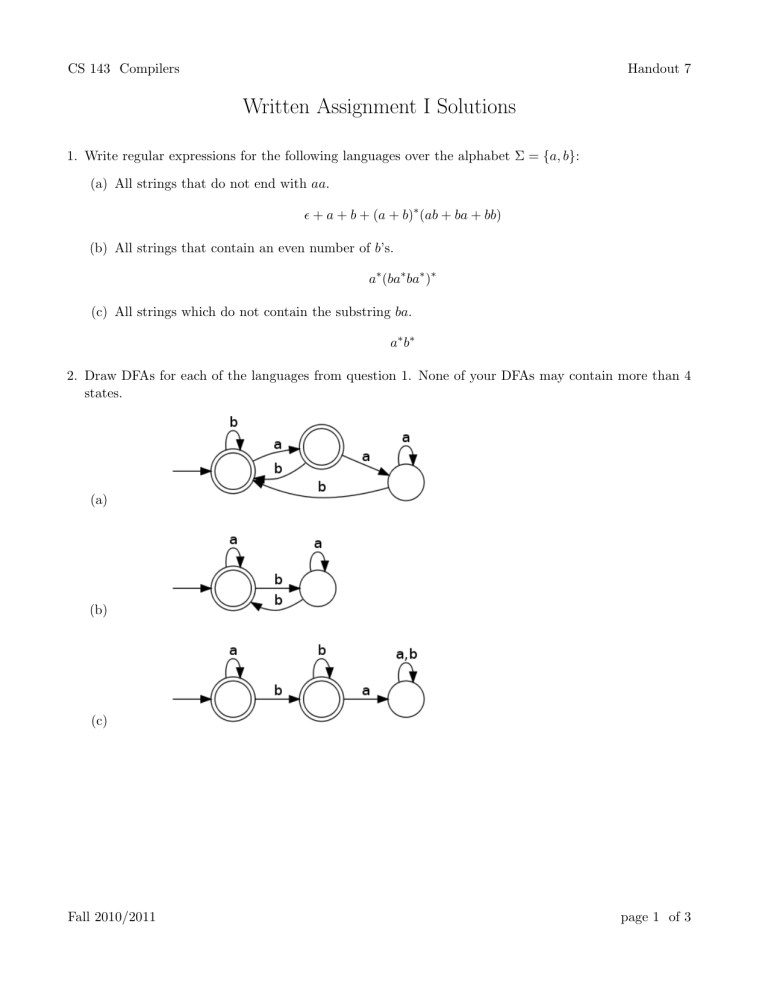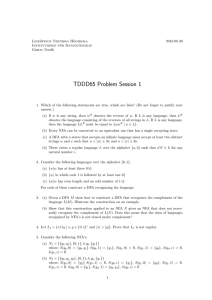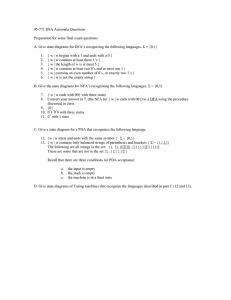Compiler Design Homework Solutions: Regular Expressions & Automata
advertisement

CS 143 Compilers
Handout 7
Written Assignment I Solutions
1. Write regular expressions for the following languages over the alphabet Σ = {a, b}:
(a) All strings that do not end with aa.
+ a + b + (a + b)∗ (ab + ba + bb)
(b) All strings that contain an even number of b’s.
a∗ (ba∗ ba∗ )∗
(c) All strings which do not contain the substring ba.
a∗ b∗
2. Draw DFAs for each of the languages from question 1. None of your DFAs may contain more than 4
states.
(a)
(b)
(c)
Fall 2010/2011
page 1 of 3
CS 143 Compilers
Handout 7
3. Consider the following non-deterministic finite automaton (NFA) over the alphabet Σ = {0, 1}.
Give a one-sentence description of the language recognized by the NFA. Write a regular expression for
this language.
• The NFA recognizes all strings that contain two 0’s separated by a substring whose length is a
multiple of 3.
• A regular expression for this language is (0 + 1)∗ 0((0 + 1)(0 + 1)(0 + 1))∗ 0(0 + 1)∗ .
4. Let Σm = {a1 , . . . , am } be an alphabet containing m elements, for some integer m ≥ 1. Let Lm be the
following language:
All strings in which at least one ai occurs an even number
of times (not necessarily consecutively), where 1 ≤ i ≤ m.
The following figure shows an NFA for the language L2 .
Construct a DFA for the language L2 that has at most 6 states. Also construct an NFA for the
language L3 that has at most 7 states.
Aside: Non-deterministic finite automata (NFAs) are no more powerful than DFAs in terms of the
languages that they can describe. However, NFAs can be exponentially more succinct than DFAs, as
this problem demonstrates. For the language Lm , there exists an NFA of size at most 2m + 1 while any
DFA must have size at least 2m . Note that the DFA for the language L3 is not as easy to construct as
the NFA for the language L3 .
Fall 2010/2011
page 2 of 3
CS 143 Compilers
Handout 7
5. Consider the string
abaabaabababbaaabaab
and its tokenization
abaa ba ababa bba aa ba a b
Give a flex specification with the minimum number of rules that produces this tokenization. Each flex
rule should be as simple as possible as well. You may not use regular expression union (i.e., R1 + R2 )
in your solution. Do not give any actions; just assume that the rule returns the string that it matches.
• (ab)*a+
• b*a?
Fall 2010/2011
page 3 of 3





